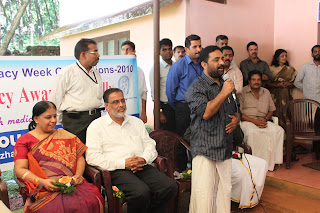Sunday, January 23, 2011
Tuesday, January 18, 2011
Monday, January 17, 2011
ADVERSE DRUG REACTION.
‘’ADR STUDY AND ITS PREVENTIONS IS TODAY’S DEMAND’’
Adverse reactions are a recognised hazard of drug therapy. They are a major clinical problem accounting for 2-6% of all hospital admissions. ADR study and its preventions is today’s demand because ADR is the fourth leading cause of death ahead of pulmonary disease, diabetes, AIDS, pneumonia, accidents, and automobile deaths. In many countries ADRs rank among the top 10 leading causes of mortality. It causes significant financial burden on national health budget.
ADRs are important causes of mortality and morbidity in both hospitalised and ambulatory patients. Many ADRs are due irrational prescribing under diagnosis .More than four drugs in one prescription may lead to ADRs. 8-10% of hospital admissions may develop ADRs. Over to million serious ADRs reported yearly one lakh deaths yearly caused due to ADRs. It adversely affects the patients’ quality of life. It causes patients to lose confidence in their doctors. It increases costs of patients care and may mimic disease resulting in unnecessary investigations and delay in treatment. India India
There is a need to study ADRs seriously to create awareness about ADRs among patients to motivate health care professionals in the hospital to report ADRs to minimise the risk. Early detection, evaluation and monitoring of ADRs are essential to reduce harm to patients and then improve public health. ADR monitoring and reporting program in a hospital encourages ADR surveillance, facilitate ADR documentation, promotes the reporting of ADRs provides a mechanism for monitoring the safety of drug use in high risk patient populations and enhances the education of health professionals regarding potential ADRs.
Lisa Mary Mani
Second M pharm( Dept of pharmacy practice)
Al- shifa college of pharmacy.
HOSPITAL FORMULARY.
HOSPITAL FORMULARY
“The hospital formulary is a continually revised compilation of pharmaceuticals, which reflects the current clinical judgment of the medical staffs including physicians, pharmacist and nurses and other experts in the diagnosis, prophylaxis, or treatment of disease and promotion of health”.
Hospital formularies originally started life in hospitals as collection of commonly prescribed pharmaceutical preparations, produced mainly for reference purpose. As time went on, the hospital formulary was adapted to the detailed information on the increasing number and diversity of medicines. However, these new and expensive preparations required ever increasing funds, and the formulary rapidly turned into a list of restricted medicines. When a hospital formulary is used effectively, it becomes the cornerstone of a formulary system, which can be one of the most effective methods of ensuring rational drug therapy and controlling the drug cost.It promotes high quality, evidence based prescribing and reduces variation in the levels of treatment provided to patients and can be used as a tool to rationalize the medicines used in standard practice.The healthcare professionals make use of the system hence it is important that it should be complete, concise, updated and easy to use.The World Health Organization (WHO) released the first edition of the WHO model list of essential drugs in 2002.The heart of the Formulary System is the Pharmacy & Therapeutics Committee (PTC).Membership will be comprised of representatives of the professional departments/services, pharmacy, house staff, nursing, administration and other interested parties.The PTC reviews the formulary one or more times in a year, for the addition and deletion of drugs.
The Need of Hospital Formulary
At present many of the pharmaceuticals on the world market represent duplicate, “me-too,” or nonessential products. Many are minor variations of a prototype drug and offer no therapeutic advantage over other drugs that are already available. Other drugs show high toxicity relative to their therapeutic benefit. In some cases drugs are newly released with insufficient information on efficacy or toxicity. Finally, many new products are for therapeutic indications not relevant to the basic needs of the population. They are nearly always more expensive than existing drugs. The formulary system is a mechanism by which professional staff can solve these.A number of other problems known to exist in most pharmaceutical system are limited drug budgets, increasing numbers of therapeutic alternatives, improper prescribing and use of medications, presence of unsafe and non-efficacious drugs, lack of unbiased drug information, high costs of handling large numbers of drugs, drugs of questionable quality on the market.
Information to be presented for individual drugs in a formulary
| Basic information | Supplementary information |
| Generic name | Common brand name(s) |
| Dosage form and strength | Price |
| Main indication | Level of use or distribution code |
| Pharmacology/pharmacokinetics | Prescription category |
| Contraindications | Patient information |
| Precautions | Labelling information |
| Dosage schedule | Storage instructions and stability |
| Adverse effects | Essential drug list number |
| Drug and food interactions | Main supplier catalogue number |
| Instructions, warnings | Procurement priority code (VEN) Re-imbursement scheme code |
Second year M-Pharm, Dept of pharmacy practice,
Al -shifa college of pharmacy.
Subscribe to:
Posts (Atom)

































